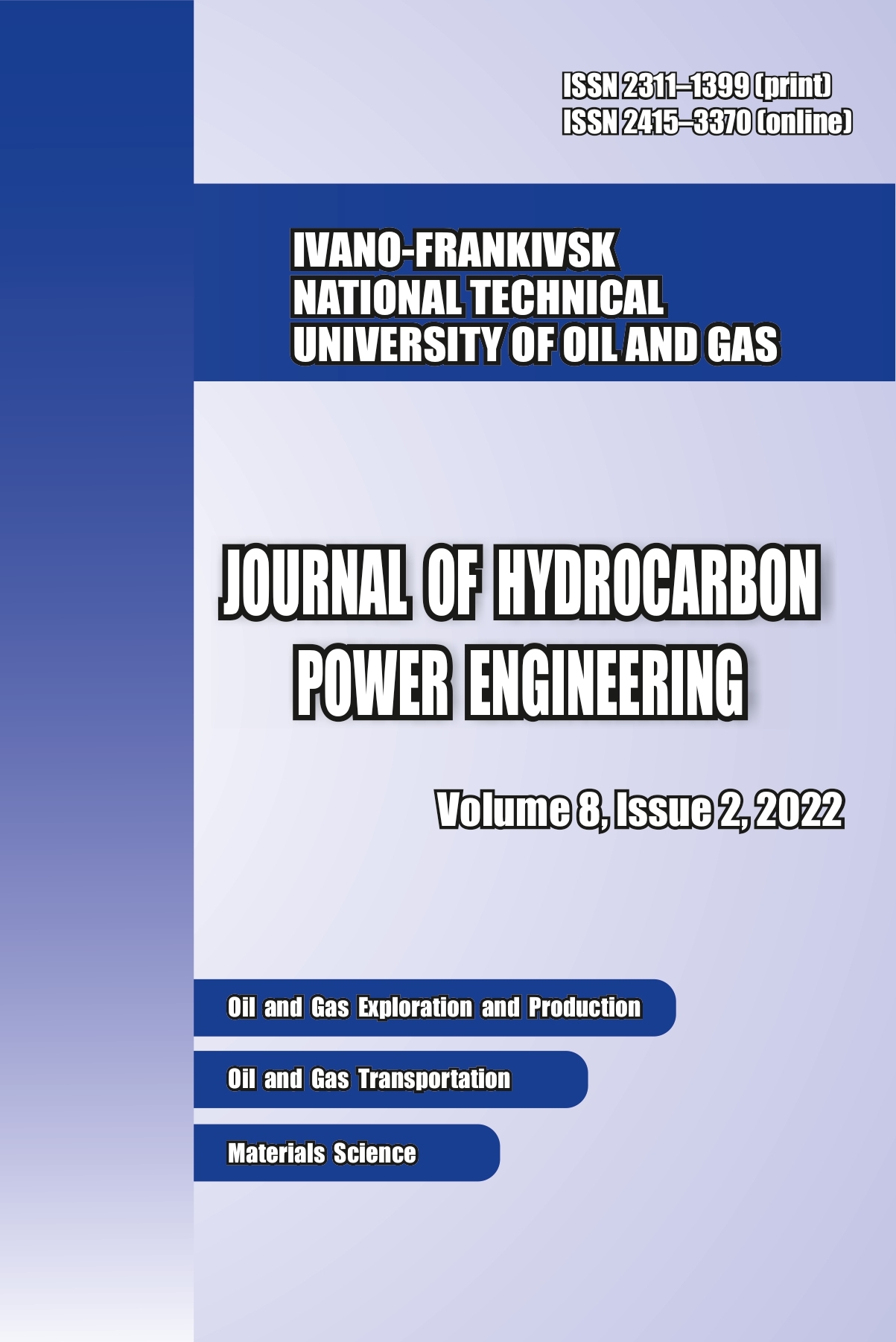Technology of forming modified epoxy composite coatings for the protection of oil and gas complex structures
DOI:
https://doi.org/10.31471/2311-1399-2022-2(18)-53-61Keywords:
adhesive strength, cyclohexanone, polyvinyl chloride, titanium (IV) oxide powder.Abstract
The work defines the adhesive strength of epoxy composite coatings formed by different technological modes, which
contain finely dispersed powder of titanium oxide (TiO2) and polyvinyl chloride dissolved in cyclohexanone. The highest values
of adhesive strength were obtained for two-layer coatings, in which the lower (adhesive) layer contains chromium (III) oxide
powder, and the upper (operational) layer consists of a modified epoxy polymer binder filled with treated titanium (IV) oxide
powder. The formation modes of epoxy composite coatings were optimized, for which higher values of adhesive strength were
obtained. Higher values of toughness by 40–45 % were obtained for epoxy composites, for which the forming technology
included exposure of polyvinyl chloride powder in cyclohexanone with the subsequent introduction of TiO2 powder. This ensures saturation of the filler particles surface with polyvinyl chloride macromolecules, which form additional chemical bonds and perceive dynamic loads. The practical purpose of the developed epoxy composite coating is to protect the constructions,
equipment and the oil and gas hardware complex from the influence of hydroabrasive flows during the transportation of oil and petroleum products, which is a complex effect of aggressive substances, water and temperature, which cause the appearance of areas of destruction on the internal surfaces of pipelines and equipment. The difficulty of applying epoxy composite coatings containing prepared finely dispersed titanium (IV) oxide powder is that the powder particles coagulation occurs. The use of cyclohexanone increases the manufacturability of the composition by reducing the ability of powder particles to coagulate.
Downloads
References
Ke Xi, Hao Wu, Chilou Zhou, Ziyang Qi, Kailong
Yang & Ricky KY Fu, [et al.] 2022, ‘Improved corrosion and
wear resistance of micro-arc oxidation coatings on the 2024
aluminum alloy by incorporation of quasi-two-dimensional
sericite microplates’, Applied Surface Science, vol. 585,
Baig, MA & Samad, MA 2021, ‘EpoxyEpoxy
CompositeEpoxy Hybrid Composite Coatings for Tribological
Applications — A Review’, Polymers, vol. 2(13), p. 179.
Hongyu Wei, Jun Xia, Wanlin Zhou, Laishui Zhou,
Ghulam Hussain, Qin Li & Kostya (Ken) Ostrikov 2020,
‘Adhesion and cohesion of epoxy-based industrial composite
coatings’, Composites Part B: Engineering, vol. 193, 108035.
Dan Liu, Wenjie Zhao, Shuan Liu, Qihong Cen &
Qunji Xue 2016, ‘Comparative tribological and corrosion
resistance properties of epoxy composite coatings reinforced
with functionalized fullerene C60 and graphene’, Surface and
Coatings Technology, vol. 286, pp. 354–364.
Chandrabhan Verma, Lukman O. Olasunkanmi,
Ekemini D. Akpan, M.A. Quraishi, O. Dagdag, M. El Gouri,
El-Sayed M. Sherif & Eno E. Ebenso 2020, ‘Epoxy resins as
anticorrosive polymeric materials: A review’, Reactive and
Functional Polymers, vol. 156, 104741.
Yongxing Zhang, Min Zhao, Jiaoxia Zhang, Qian
Shao, Jianfeng Li, Hang Li, Bo Lin, Meiyan Yu, Shougang
Chen & Zhanhu Guo 2018, ‘Excellent corrosion protection
performance of epoxy composite coatings filled with silane
functionalized silicon nitride’, Journal of Polymer Research,
vol. 25, p. 130.
Yan Hao, Xiying Zhou, Jiajia Shao, Yukun Zhu.
, The influence of multiple fillers on friction and wear
behavior of epoxy composite coatings, Surface and Coatings
Technology, vol. 362, p. 213–219.
Jiaoxia Zhang, Weirui Zhang, Liping Wei, Liuyue Pu,
Jianping Liu, Hu Liu, Yingchun Li, Jincheng Fan, Tao Ding &
Zhanhu Guo 2019, ‘Alternating Multilayer Structural Epoxy
Composite Coating for Corrosion Protection of Steel’,
Macromolecular Materials and Engineering, vol. 304, iss. 12,
Balázs Jakab, Ileana Panaitescu & Norbert
Gamsjäger 2021, ‘The action of fillers in the enhancement of
the tribological performance of epoxy composite coatings’,
Polymer Testing, vol. 100, 107243.
Savchuk, P, Matrunchyk, D, Kashytskyi, V,
Sadova, O & Moroz, I 2019, ‘The influence of metal oxide
powders on the physical and mechanical properties of epoxy
composites for the protection of constructions made of
aluminum alloys’, Ukrainian Journal of Mechanical
Engineering and Materials Science, vol. 5, no. 2, pp. 16–24.
Savchuk, P, Matrunchyk, D, Kashytskyi, V,
Sadova, O & Moroz, I 2020, ‘The influence of ultrasonic
treatment on the mechanical properties of epoxy composites
modified with fine powder of titanium oxide’, Proceedings of
the XXII International Scientific and Practical Conference
«International Trends in Science and Technology» (Warsaw,
Poland), vol. 1, pp. 13–20.
Myroniuk, ІF, Cheliadyn, VL, Кotsiubynskyi, VО
& Мyroniuk, LІ 2011, ‘Structure and morphology of TiO2
particles, obtained by liquid phase hydrolysis of TiCl4’, Solid
state physics and chemistry, vol. 12, iss. 2, pp. 416–427.
Downloads
Published
How to Cite
Issue
Section
License
Copyright Notice


1.png)





1.png)
